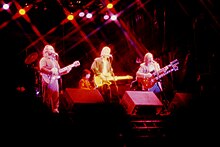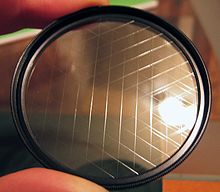Effects filter


In photography, filters are generally understood to mean glass or plastic panes, but also foils made of plastic or gelatine and other materials, which are usually introduced into the beam path of the camera or , more rarely, a magnifying device in the darkroom or the slide projector in order to make targeted changes to the Image. Conversion filters and correction filters are mostly used to adapt to special lighting conditions (see color temperature ) or, in black and white photography, to influence the tonal values .
Effect filters or creative filters also aim at more extensive effects. Certain effects are consciously used as a design tool to alienate photos.
General properties
Higher-quality filters are usually provided with one or more coatings (anti-reflective coatings). These layers are intended to avoid scattered light and reflections and thus deliver optimal image results. Many effect filters have a rotatable socket. Almost all effect filters are dependent on the focal length of the lens and the aperture setting.
Types
Star filter
Star filters, also known as cross filters or, depending on their structure, also called grid filters, shape highlights in the motif into stars. The number of rays usually varies from four to eight or sometimes sixteen. The number and orientation of the grid lines in the filter determine the intensity and orientation of the light crosses .
Motifs such as the sun, the lighting of a city, candles and light reflections on water, metal or glass are given a much stronger character by these filters. The light sources should stand out from the background. This filter can also be combined very well with others, such as color gradient filters.
Rainbow filter
Rainbow filters , also known as spectral effect filters or color star filters, have a barely visible microprismatic structure that ensures that bright light sources and reflections are split into multiple rays and multicolored (into the spectral or rainbow colors). The designs can vary, but are all based on the same functional principle.
- Spectral 36 ×
- The orientation of the microprismatic grid is designed to surround the respective light points with a rosette consisting of 36 colored rays (see example 2).
- Spectral ring
- With this filter, the spectral colors appear ring-shaped around any light source or reflection. So not like an arrow, but circular (see example 3).
- Spectral 8 ×, also called pulsator
- The arrangement of the microprismatic grid is chosen so that 8 arrow-like rays emanate from each light source or reflection (see example 4).
In order to use spectral filters in the design of the motif, one should ensure that the background, as with the grid filter, is not too brightly illuminated, because then the alienated light reflections do not come into their own. These filters are suitable for backlight (sun) or bright water reflections. It can also be very interesting to use the filter at night with artificial light sources. This often allows very surprising effects to be achieved.
Graduated filter
A neutral gray gradient that extends from light to dark allows the image to be partially darkened. In this way, too high contrasts that exceed the density range of the film / sensor can be corrected by darkening the light areas. It can also be used to create dramatic lighting moods (e.g. particularly dark skies). Colored gradients combine these with coloring parts of the image. The darkening of image areas that are too bright can also be useful in digital photography, especially if the subject contrast exceeds the density range of the recording sensor. Graduated filters are also available in versions in which the light-dark transition can be moved.
Prism filter
Prism filters, also called “trick lenses”, reproduce the motif several times, sometimes distorted, with three or more surfaces.
Soft focus
Give the picture a “blurred” or “dreamlike” impression. These filters can also only cover parts of the image, for example to show the center of the image or one half of the image in focus and to soften the rest of the image. The soft focus can also be coated in color in the soft part of the filter in order to give this part an additional color effect. There are various types of soft focus filters available on the market: A microscopically grained filter disc, for example like an anti-reflective glass on a photo carrier, creates a focus-independent blurring effect (similar to Gaussian blurring as digital image processing). A filter in which concentric rings have been ground into a flat pane of glass creates a normally sharp image on which a portion of blurring is superimposed. This filter is also called "Duto" after the inventors Jenő Dulovits and Miklos Tóth . Another variant uses irregularly distributed knobs, similar to water droplets.
Similar effects can also be created by brushing a neutral filter such as a Skylight or UV filter from the edge with a finger slightly greased with Vaseline . This allows both the strength of the effect and the area to be softened to be controlled quite well.
Vignetting filters and masks
Vignetting filters and masks are used to darken parts of the image or mask out parts of the image in the event of double exposures. The doppelganger filter (also dual image filter) is a half black faceplate in a rotating mount with a number wreath. Please note that the camera must be equipped for double exposures. A stable tripod is also essential. The Doppelganger recordings to be achieved do not necessarily have to be about people. For example, landscapes with an open sky are ideally suited as motifs for exposing the sun or moon. After exposing one half of the image, the attachment is rotated 180 ° to the opposite side and the other half of the image is exposed. In order for recordings of this kind to be successful, a very specific aperture must be used for the lens or focal length used. For smaller focal lengths, a more open aperture (i.e. a smaller f-number) must be selected. The best way to determine this is through a series of tests. The best result of a double exposure is the image with the smallest difference in brightness in the center. The arrangement of people for doppelganger motifs against a dark background is problem-free. With good settings there will be no dividing line.
Self-made filters
With colored foils, clear glass panes painted with grease cream or colored pencils that are held in front of the optics, numerous other effects can be achieved.
Picture effects
In digital photography , some of the effect filters have become dispensable, since the effects can be generated from the unadulterated image data afterwards through digital image processing with graphic filters . Soft focus filters can be better implemented with image processing, for example. Examples of optical filters that also improve the raw data in digital photography are polarization , skylight , UV , gradient and neutral density filters .
In the case of moving images such as in the television and film sectors, however, filters are still often used today. Star, gradient and prism filters are most commonly used.



